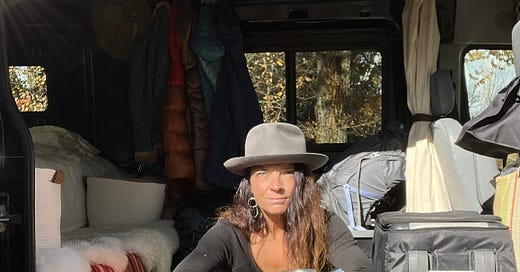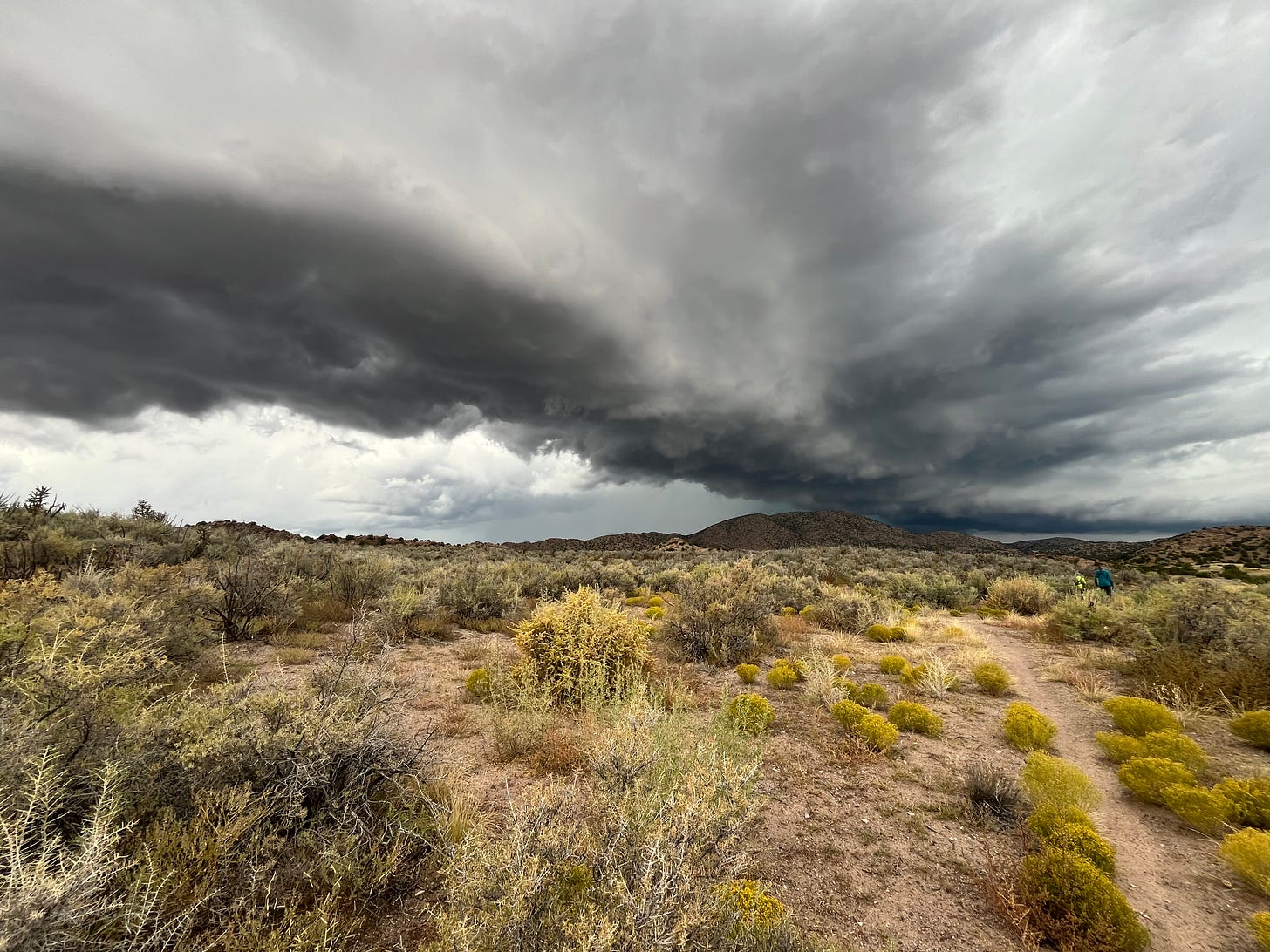It’s no secret that social media is a disaster: We’re barraged by a stream of images and videos of people showcasing their “tuned up” faces, buffed bodies, ah-mazing living spaces and travel adventures. People living their best lives! We all know it’s a sham. The carefully curated images, the sculpted environments, the digital tools used to tuck in a few extra inches, remove a wrinkle or two. And yet, comparisonitis—the off-the-rails version of our natural human impulse to evaluate ourselves relative to others, judging our levels of attractiveness, wealth, intelligence, and success (or creativity, coolness, athleticism, mindfulness, wardrobe, you name it)—is alive and well: we’re comparing ourselves (yes, our real-world selves) to these mirages. Moreover, we’re suffering from it, adding fuel to an already burning epidemic of anxiety, depression, loneliness, and FOMO (fear of missing out). (Breathe, people, breathe. And, yes, just get outside.)
The social mystique around #vanlife is no different—the long horizons and stunning sunsets, the quiet, lonesome spots, the independence! the adventure! There’s no doubt it taps into a deep vein of human longing: The urge to run and roam and explore. The quest for the unknown, the pull of the wild. The terrifying yearn to throw off ill-fitting social shackles.
As travel writer Anthony Sattin attests, we’ve come from a long heritage of nomadism; we’ve just forgotten it. In an interview with the New York Times about his book, Nomads: The Wanderers Who Shaped Our World, he says we began to settle and domesticate some 12,000 years ago and, while “the process took a long time it has been immensely successful given that most of the eight billion of us are now settled and over half of us now live urban lives. That success has now become problematic—our cities, like much else in our world, are in crisis. The need for a new way of living and of thinking has never been more necessary…And those of us who find it challenging to live in one place, or at least find that settling down makes huge demands on us, can find solace in the knowledge that they might still be “wired” to live on the move.” (Phew. My restlessness is not unfounded; these deep-seated urges are encoded in my DNA.)
Despite the mystique and the inexplicable pull, every rose has its thorn, and all those social media mirages have their underbellies. Though the three joyful weeks I spent meandering through the desert southwest (see The Joy of Kickin’ Around) were close to perfect, there was that one thing. There always is. In this case, it happened the day I pulled into a secret US Forest Service spot, a little-known open meadow in the mountains, surrounded by split-rail fencing, just off a major highway and at an almost-perfect halfway point for many of my adventures south. I’d been there several times before. I parked and spent the afternoon and early evening working. There was a meager cell signal but enough to submit a document I should have finished days before. I’d noticed an encampment not all-that-far down the meadow. It was one of those scenes that piqued my feminine radar: the massive RV, the ATV, the truck, the dog.
I was not wrong: Nearing twilight, a young man appeared, set himself up in a crouched position at a table and began firing rounds across the split rail fence and into the hillside. Yes, all in a camping area. I watched. He might have been shooting at a target, but it wasn’t clear. He walked out to the rail, turned around, and walked back. Another round. All told, he fired off a dozen or so rounds. I stayed, completing my document. It was fully dark by the time I sent it off. I watched. The man got on his ATV, started the engine and pulled around to an opening in the fence. He idled for a while, waiting for who-knows-what, and then drove forward, skirting along the outside of the fence. Eventually, he drove off, up and over a hill and into the dark.
Moments later, a sheriff’s car slow rolled into the place, inched right by my van, continued down the hill, and parked, headlights pointed at the encampment, engine still running. A man got out and walked around, peered through the windows, checked out the table, looked at the truck. He stayed a few minutes before returning to his car, turning it around to face the exit, and idling. We both waited. I had a sinking feeling this was another one of those—oh, the police checked it out, there was nothing going on. I considered getting out of my van and walking over to tell him the guy is just up there but thought better of it, not wanting to be mistaken in the dark for anything other than what I was—a solo woman camped next to this disconcerting scene. My instincts told me not to get involved. The cop waited a while and then slowly began driving away. I again considered getting out, but still, chose otherwise. I waited. Not five minutes after the cop car drove away, the man and his ATV returned from over the hill.
I sat a while, in my van, in the dark. It was late enough that I really didn’t feel like dealing with this. I wasn’t scared. I wasn’t even anxious. I just wanted to go to bed. But then, the idea of going to sleep solo (no longer with even my best dog friend) next to whatever this scene was seemed like a bad idea. I procrastinated a bit longer, because I was tired, because it was dark, because I had no fucking idea where I was going, and because I just didn’t feel like dealing with it. But, slowly, reluctantly, I did. I got on one of my apps, found another campground twenty minutes closer to home, and, with full knowledge that it might not be an answer, started my engine and pulled out. I soon arrived to find the campground was closed for the season.
I moved on, now headed toward the tangle of box stores and highways and lights and billboards that constitutes the southern part of the Salt Lake Basin, and immediately I knew—I was headed for the next Walmart. Seasoned travelers will know that some—but not all—Walmart parking lots welcome travelers and campers, have security cameras and lights, and are generally considered safe enough places to ditch it. The first Walmart I found was a bust—visible from the highway, too much commotion, too many unknown people. The second, however, was a bit further off the highway in a quieter area. This would due. I parked within sight of a tower of cameras, blocked out all my windows, and crawled into bed.
Lying in bed, I received a text—my friend asked where I was laying my head. I recounted my last few hours. His response: Good choice, woman. And, with that, I fell asleep and slept soundly ‘til daybreak in a spot considered by some, the underbelly of nomadic culture, by others, a requisite data point on any real American sojourn. I choose the requisite adventure.
xo Wendy
P.S. If you enjoyed reading this piece, please give it a “♡”!







I have no idea of how many parking lots of various kinds, big box stores, damn Cracker Barrel, Cabela's, truck stops, rest areas, etc, where we parked our RV overnight in our 20+ years of meandering about. We also enjoyed some campgrounds for the amenities. We were not full-timers and usually had a home base somewhere (NM, OK, CA, AZ). I see folks here like you, Holly Starley, April Isaacs and a few others, and I sense missing out now since giving up our 8th and last RV, a Leisure Travel Van. Figuring out a way to maybe get back "on the road again" (Willie Nelson) and immerse ourselves in that wonderful environment.
Skillful choice, Wendy.
My husband and I spent two nights in the parking lot of a Rite Aid, a local grocery store and a pizza place while waiting for a part for the RV. He went in and talked to the managers of each place to let them know, and we of course purchased a pizza, a bottle of wine and a few groceries. It was one of the better stops we made on that particular trip.